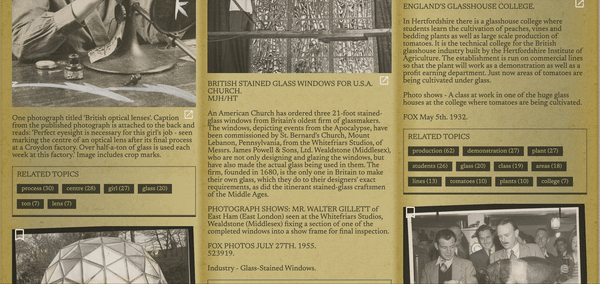In the words of the American writer Susan Sontag, “To collect photographs is to collect the world.” And to see the world as it was, from dramatic historical events to the quirks of everyday life, there’s no better place to begin than a photo archive. Newspapers – whose photojournalists capture everything from grand state ceremonies to dog-grooming competitions – provide us with some of our most important archives.
The Daily Herald Archive has more than three million photographs of life in Britain during the 20th century. Founded in 1912, the Daily Herald was in print for 52 years, spanning two World Wars, the postwar era and the swinging ‘60s. Today, the archive provides a unique portrait of a country undergoing great change, while also documenting local eccentricities and everyday life. Now held at the National Science Media Museum in Bradford, the Daily Herald Archive is the Science Museum Group’s largest collection.
Today, Google Arts & Culture is launching a new digital hub that showcases this incredible archive of more than 70,000 digitized artifacts, along with a new AI-powered experiment that allows you to explore and create your very own edition of the Daily Herald.

Did you know...? The Daily Herald was once the UK’s most popular newspaper.
The Daily Herald became the first paper to achieve two million daily net sales back in June 1933. Founded in 1912 by members of the British labor movement, the newspaper was known for its anti-establishment stance, its socialist politics and innovative use of photojournalism.
The archive provides a vivid snapshot of British life
The Daily Herald Archive contains pivotal moments in global history alongside day-to-day activities of Britons across the country. Fromdog shows to gymnastics, users can enjoy an authentic portrait of 20th-century Britain.
It contains bonafide masterpieces
Many of the photos in the Daily Herald Archive – taken by press agencies, freelance photographers as well as by Daily Herald photographers – are real masterpieces of photographic art and composition. Check out this image of fountain swimming and this one of awoman making light bulbs.
Alfred Hitchcock!
In 1928, The Daily Herald openeda contest for the public to submit photographs or ‘snaps’ of their holidays. The rules stipulated that no professional photographs would be considered. The competition proved exceedingly popular, with none other than cinematic great Alfred Hitchcock joining the panel of judges in 1936.
The Daily Herald’s story was nearly over before it had begun
The Daily Herald had a very uncertain start to life – it actually stopped publishing after its first four months. The newspaper began as a strike sheet for the London printing unions, but once the fight for better working conditions was won, the Herald closed its doors on 28 April 1911. However, as it had proved so popular, the paper relaunched the next year.
How to enjoy the collection
Now, you can explore the Daily Herald Archive from anywhere in the world.
The new experiment on Google Arts & Culture, My Daily Herald, allows you to create an AI-powered personalized newspaper that takes the first edition of the Daily Herald as its starting point, and invites you to create your own bespoke version. The experiment uses Optical Character Recognition and Natural Language Processing to create the metadata and imagine what an edition of the Daily Herald might look like today.
The hub draws all this together alongside explanatory stories authored by the National Science and Media Museum archive and curatorial team. These explore key topics and themes such as: the history of Kodak photography, Women in radio and A history of the Ideal Home Show.
So jump right in and discover this extraordinary archive: goo.gle/dailyheraldarchive